Women Directors -- Interpreting The Research
The 8 sisters of The InterOrganization Network (ION) released
their 2006 surveys of "the magic number" -- the share of women
on corporate boards of directors. While Catalyst Inc. has been
conducting such surveys of the Fortune 500 firms since 1995, several
dispersed women's leadership advocates have begun conducting their
own research. Trying to compare the results of these two groups
was confusing at first. If Catalyst's Fortune 1000 average
in 2004 was 13.8%, why was it that everyone else was so low? The
chart, below, shows the comparative data with a red line indicating
Catalyst's Fortune 1000 share of women directors.
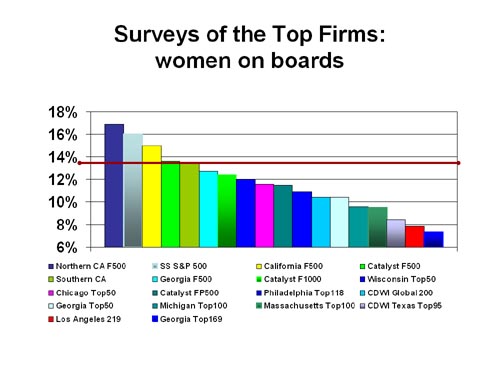
We looked first at the geographic distribution of Fortune 500 and
501-1000 sized firms across the country. The ION group states were
not the largest in terms of number of firms per state. Only California
ranked among the top states. After that, among the ION group, IL
ranked 4th in the number of Fortune 1000 firms, Pennsylvania was
6th, Michigan was 9th, Georgia was 10th, Florida was 11th, Wisconsin
and Massachusetts were 16th and 17th.
Three states with the most Fortune 1000 firms were NOT among the ION groups: Texas, New York and Ohio at second, third and fifth.
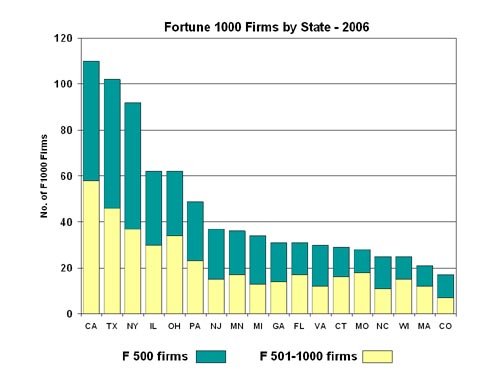
For the first time, in 2006, all 8 groups surveyed their firms at
the same time, although they did not all survey the same number
of firms per state. The groups chose to include seven times as many smaller companies (1,126 firms) than Fortune 500 firms (only 153 companies)
which were located in their states. This larger number produced
an average that is almost 5% points LESS than that reported by Catalyst
Inc. which covered just the top Fortune 500 firms.
Generally, there is a tendency of larger firms to have higher
shares of women directors. Looking at the Top 50 and Top 100 firms
in a state, rather than the Fortune 500 or Fortune 1000 shows
different results. Assuming 100 women were added to the boards
of directors on the 153 companies among the Fortune 500 firms
in the 8 states, the result would be a 6.5% improvement in the
share of women on boards (assuming the average board size at that
level is 10 members). If the same 100 women were added to the
boards of directors of the 1,126 smaller firms tracked by the
ION groups, that would result in only a 1.1% increase (where the
average board size is probably closer to 8). The result would
be even worse if average board size were larger.
The chart below contrasts the average reported by ION states
vs. Catalyst's average share of women directors covering the Fortune
500 firms, nationwide. The graphic shows that each region's larger
sampling has a lower average share of women directors than was
the case with the Fortune 500 firms within those same states.
The comparative data is presented in the table below the graphic.
Why would the ION groups focus on the bigger number of firms and
the smaller share of female directors?
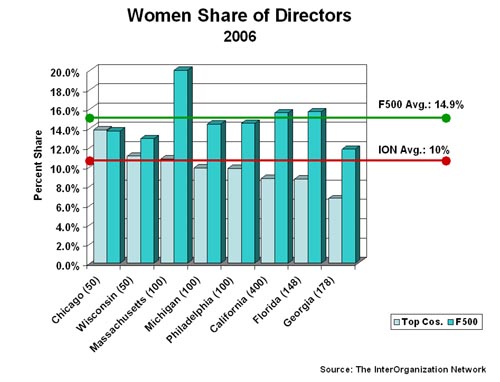
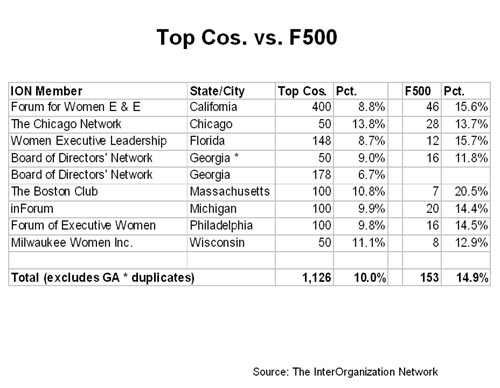
By presenting the lower average scores, the "bad news" is exacerbated,
the newspapers pay greater attention, and more "Action Required!"
imperatives can be espoused. If 8 organizations keep singing the
same chorus, it must be true.
"Sadly, however, significant change has not taken place . .
. Overall, the composition of corporate boards has remained stolidly
white and male." ["Corporate Boards Miss Opportunities to Add
Women", ION Press Release, February 2007, p. 3.]
Catalyst Inc. does a similar thing by reporting the "bad news"
from their surveys of the Fortune 500 firms. Catalyst's 2006 census
bemoaned the "bad news" that women held "only 14.6%" of the director
seats at Fortune 500 firms, "down from 2005." The reality is that
women directors lost a whopping .09% over last year, resulting
in a net decline of 4 director seats. More "ACTION REQUIRED!"
The change in the percentage shares and the absolute numbers
of women directors needs to be put into perspective. One cause
of that precipitous drop could have been the merger of Golden
West Financial into Wachovia, resulting in the elimination of
5 women-director seats. This year was another year of major mergers,
acquisitions, and consolidations among the top Fortune 500 firms
as shakeout occurred on many economic fronts.
Another important reality is that boards have reduced their
board size dramatically, tightening up on director headcount,
responsibilities and committee roles. The chart below shows the
drop in average board size over the past 11 years, using Catalyst's
reported data. It shows that reductions have occurred in both
total board size and in the number of men on board since 1995.
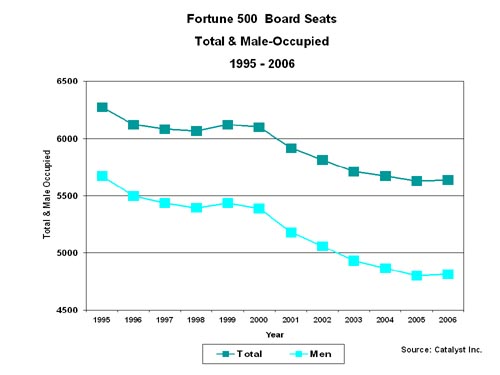
Now contrast that graph with one that shows the growth in the number
of women on boards at Fortune 500 firms, on the right axis, versus
the decline in total board size, on the left axis. True, the scales
are different, so to see the net comparative differences, we update
the chart showing the overall impact over 11 years for the total
board seats, male-occupied seats and female-occupied seats. Women
are ahead by 223 seats compared to men who have lost 861 seats.
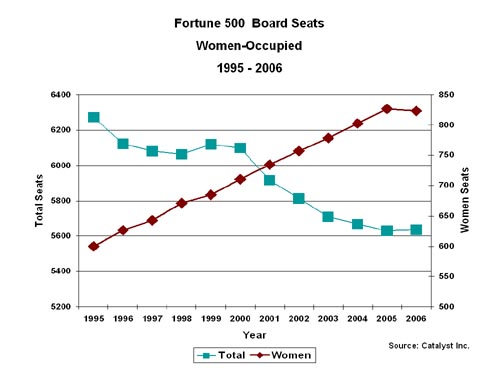
Mergers and acquisitions have trimmed the available supply of board
seats, and boards themselves have reduced their average board size.
Directors have been aggressively pursuing female talent to serve
on top Fortune 500 boards, even to the extent of replacing men.
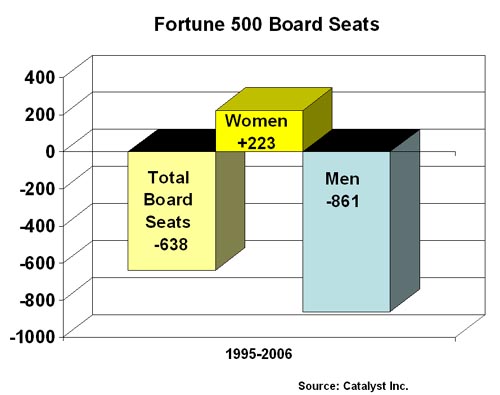
Does this mean that "Action NOT Required??" Not at all. It does
suggest that women are finding many new director opportunities at
smaller, more entrepreneurial and new technology firms. This is
affirmed by the press release announcements throughout 2006 from
NewsOnWomen.com. There
were more women added to corporate boards of directors of all sizes
in 2006 (278) than the total net increase in the number of female
directors at the Fortune 500 over the past 11 years (223). But that
good news is hidden when you only look at "the magic number"
-- the share of women directors as a percent of the total.
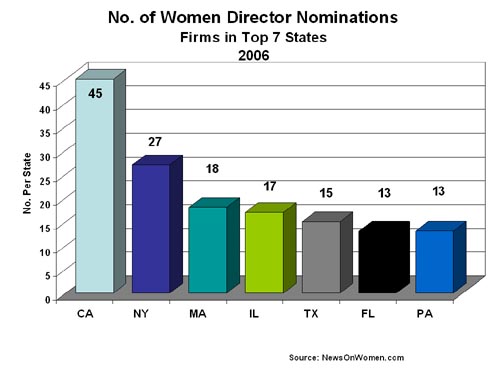
New York, Texas and Ohio also are important states (not included
in the ION groups) to track in the progress of women named to corporate
boards. But, in any event, it would be nice if all states could
begin with the Catalyst data, then show a consistent number of additional,
smaller firms so that we could monitor real progress at these two
different groups.
For some women even in 2007, a seat on a major public board
at the Fortune 500 sized firm might be too big a
leap of faith and risk on the part of the many talented women who
aspire to corporate board roles. Many women recognize the challenge and
opt to test their metal in the next tier of Fortune 500-1000 sized firms or even in firms smaller than those. That is a good strategy for managing risk as one undertakes
a board role for the first time. Female director candidates are taking the right "action required!" as they pursue public corporate board opportunities.
Take another look at the results from The Chicago Network's
2006 survey of the Top 50 (for-profit) Corporations vs. the Top
35 Nonprofits. From the looks of it, a lot of women in Chicago
have followed their advice, "get thee to a nonprofit board." But,
that advice apparently has not trained or prepared the very large
number of women to serve on for-profit boards of directors.
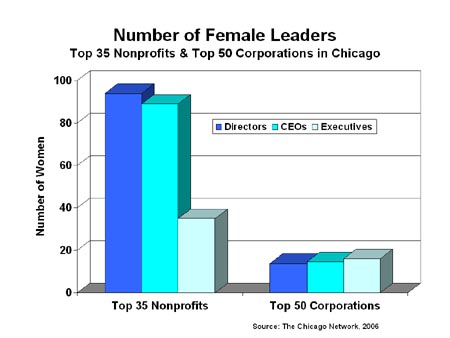
Have the ION groups learned from this research? Are they pursing the right course of
action to help women advance to leadership positions? Since we're
expecting corporate, for-profit boards of directors, their shareholders
and investors to take action to bring women on board, wouldn't
it be appropriate to use a for-profit, shareholder or investor
strategy? Isn't that what shareholder meetings are about? what
proxy meetings are all about? what investor resolutions are all
about? Therefore, wouldn't it be smarter for women advocates who want other
women to advance to board roles to learn more about how the shareholder
nominations and committees work?
March and April are the two busiest months in terms of stockholders
meetings, so we should not be surprised if there are somewhat
fewer women director nominations and announcements during those
two months. Nominating and Governance Committees are likely to
be meeting in the 2nd and 3rd quarters of the year, when we would
expect more announcements and press releases about new women added
to their boards of directors.
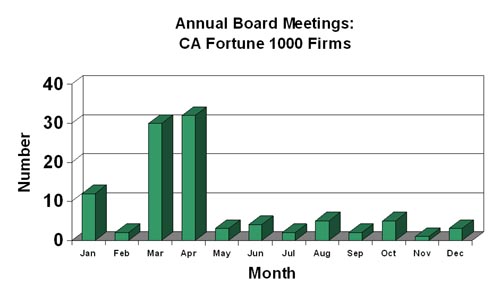
If women want to ensure that women are part of the leadership of
our corporations, they will need to "get into the game" and figure
out how governance works and how boards work. Just like any other
shareholder or investor.